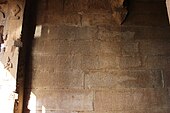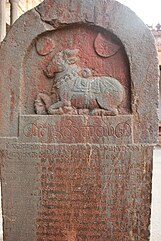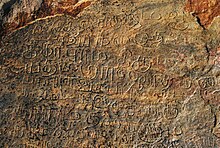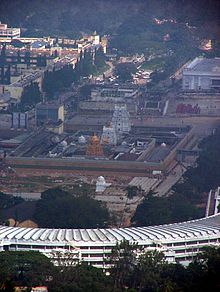
The Vijayanagara Empire was a medieval Hindu empire that ruled much of southern India. It was established in 1336 by the brothers Harihara I and Bukka Raya I of the Sangama dynasty, members of a pastoralist Gadariya community that claimed Kuruba lineage.
The Deccan Sultanates were five late-medieval Indian kingdoms—on the Deccan Plateau between the Krishna River and the Vindhya Range—that were ruled by Muslim dynasties: namely Ahmadnagar, Berar, Bidar, Bijapur, and Golconda. The sultanates had become independent during the break-up of the Bahmani Sultanate. The five sultanates owed their existence to the declaration of independence of Ahmadnagar in 1490, followed by Bijapur and Berar in the same year. Golconda became independent in 1518, and Bidar in 1528.
Sultan Quli Qutb-ul-Mulk, more often though less correctly referred to in English as Quli Qutb Shah (1485–1543), was the founder of the Qutb Shahi dynasty, which ruled the Sultanate of Golconda in southern India from 1518 to 1687. Of Turkoman origin and born in Persia, he originally served the Bahmani sultan, and was awarded the title Qutb-ul-Mulk as military chief; he eventually took control of Golconda.
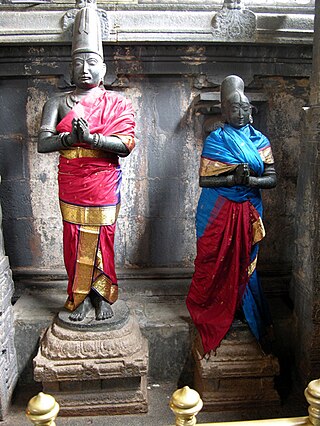
Achyuta Deva Raya was an emperor of Vijayanagara who succeeded his older brother, Krishnadevaraya, after the latter's death in 1529 CE.

Rama Raya was a statesman of the Vijayanagara Empire, the son-in-law of Emperor Krishna Deva Raya and the progenitor of the Aravidu dynasty of Vijayanagara Empire, the fourth and last dynasty of the empire. As a regent, he was the de facto ruler of the empire from 1542 to 1565, although legally the emperor during this period was Sadasiva Raya, who was merely a puppet ruler. Rama Raya was killed at the Battle of Talikota, after which the Vijayanagara Empire got fragmented into several semi-independent principalities paying only nominal allegiance to the empire.

Deva Raya I was a king of the Vijayanagara Empire. After Harihara II died, there was a dispute between his sons over succession, in which Deva Raya I eventually emerged victor. He was a very capable ruler noted for his military exploits and his support to irrigation works in his kingdom. He modernized the Vijayanagara army by improving the cavalry, employed skilled archers of the Turkic clans and raised the fighting capacity of his bowmen and imported horses from Arabia and Persia.
Saluva Timmarusu was the prime minister (mahapradhana) and military commander of Krishnadevaraya. He is also known as "Appaji". He had also served as the prime minister under Viranarasimha Raya and Tuluva Narasa Nayaka.
Pemmasani Nayaks were a ruling clan in the south Indian state of Andhra Pradesh. They came into prominence during Vijayanagara Empire. After the Battle of Talikota in 1565 AD, the collapse of Vijayanagara Empire led to the emergence of Pemmasani Nayakas in the Rayalaseema region. They belonged to the Kamma social group.
Tuluva Narasa Nayaka was an Indian general and later an Imperial Regent who founded the Tuluva dynasty of the Vijayanagara Empire. He was the father of the Emperors Viranarasimha Raya, Krishnadevaraya and Achyuta Deva Raya.

The Battle of Raichur was a battle fought between the Vijayanagara Empire and the Sultanate of Bijapur in 1520 in the town of Raichur, India. It resulted in a decisive victory for Vijayanagara forces, and the Bijapur ruler was defeated and pushed across the river Krishna.

The recorded history of Andhra Pradesh, one of the 28 states of 21st-century India, begins in the Vedic period. It is mentioned in Sanskrit epics such as the Aitareya Brahmana. Its sixth-century BCE incarnation Assaka lay between the Godavari and Krishna Rivers, one of sixteen mahajanapadas. The Satavahanas succeeded them, built Amaravati, and reached a zenith under Gautamiputra Satakarni.
Pemmasani Ramalinga Nayudu was an army commander of a Vijayanagara military unit. An inscription dated to 1544 CE, which was found in Tallaproddatu, states that Pemmasani Ramalinga enjoyed the nayankara of the village. Phillip B. Wagoner who analysed 17th century Telugu text Rayavachakamu noted that it is not known whether Ramalinga Nayudu served Krishnadeva Raya or some later ruler.

Mahamantri Timmarusu is a 1962 Indian Telugu-language historical drama film directed by Kamalakara Kameswara Rao. It stars N. T. Rama Rao, Devika, Gummadi with music composed by Pendyala Nageswara Rao. The film was produced by N. Ramabrahmam, A. Pundarikakshayya under the Gowtami Productions banner. The film won the President's silver medal for Best Feature Film in Telugu at the 10th National Film Awards.
Shitab Khan, also spelled Chitapu Khan, was born Sitapathi Raju in the Telangana, India. He joined as a foot soldier in the army of Humayun Shah, the Bahmani Sultan, and rose up the ranks to acquire senior captaincy, his own jagir and the title 'Shitab Khan'. He always used the title in his inscriptions but never actually converted to Islam.

Kondapalli Fort, also locally known as Kondapalli Kota and Kondapalli Quilla, lies to the west of Kondapalli in Ibrahimpatnam mandal of NTR district in Andhra Pradesh, India was built by Prolaya Vema Reddy of Reddi Kingdom during the 14th century CE. It was initially built as a leisure place and business center and later served as a military training base for the British rulers. According to some other historians it was built in 1360 CE by Anna Vema Reddy after he captured Kondapalli from Mudigonda Chalukyas, the fort has been home to several dynasties, from the Reddi rulers Gajapati dynasty to the Nizam Nawabs, and then the East India Company.

Taj ud-Din Firoz Shah, also known as Firoz Shah Bahmani, was the ruler of the Bahmani Sultanate from 16 November 1397 to 22 September 1422. Firuz Shah is considered an important ruler of the Bahamani Sultanate. He expanded his kingdom and even succeeded in conquering the Raichur Doab from Vijaynagara kingdoms.

The Āmuktamālyada is a Telugu epic poem composed by Krishnadevaraya, the ruler of the Vijayanagara Empire, in the early 16th century. Amuktamalyada translates to "One who offered the garland after wearing it herself". Considered as a masterpiece, the Amuktamalyada describes the legendary wedding of the Hindu deity Ranganayaka, an avatar of Vishnu, and Andal, one of the poet-saints called the Alvars, at Srirangam.

Prataparudra Deva was the third Gajapati emperor of Odisha from the Suryavamsa Gajapati Empire founded by his grandfather Kapilendra Deva Routaraya. He reigned from 1497 to 1540 CE. Besides being a monarch, he was a devout Vaishnava and adherent of the famous saint, Sri Chaitanaya who arrived in Odisha during his reign. His life was extremely occupied with overwhelming military campaigns in defense of his inherited territory from three frontal invasions by the enemy states Vijayanagar, Hussain Shahi dynasty of Bengal and Turko-Persian Qutb Shahi dynasty of Golconda. He lost large portions of his territory to the neighboring enemy states initiating the dissolution of Odisha's military hegemony and imperial status that continued for nearly a period of 600 years before him.

The Deccan Sultanates-Vijayanagara Conflicts were a prolonged period of military conflict lasting from 1495 to 1614 This series of battles pitted the rival powers of the Deccan Sultanates against the Vijayanagara Empire. Over the course of approximately 120 years, these two entities engaged in a series of wars and skirmishes that were marked by significant displays of military strength and strategic maneuvering.

The Krishnadevaraya's Bahamani Expedition was a pivotal event in the history of the Bahmani dynasty and the Vijayanagara Empire. It marked a significant escalation in tensions between the two powers.


